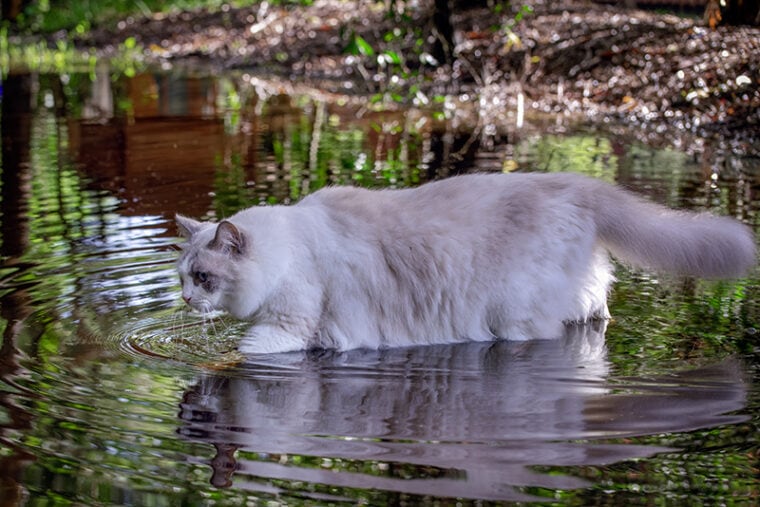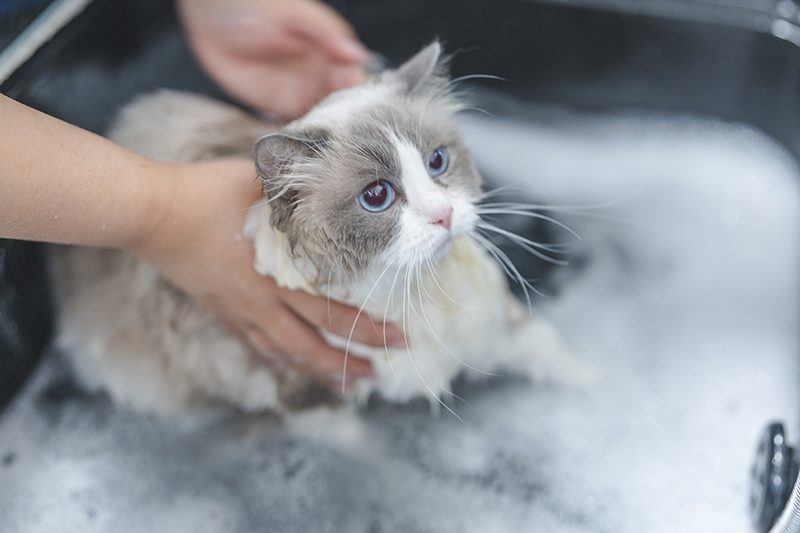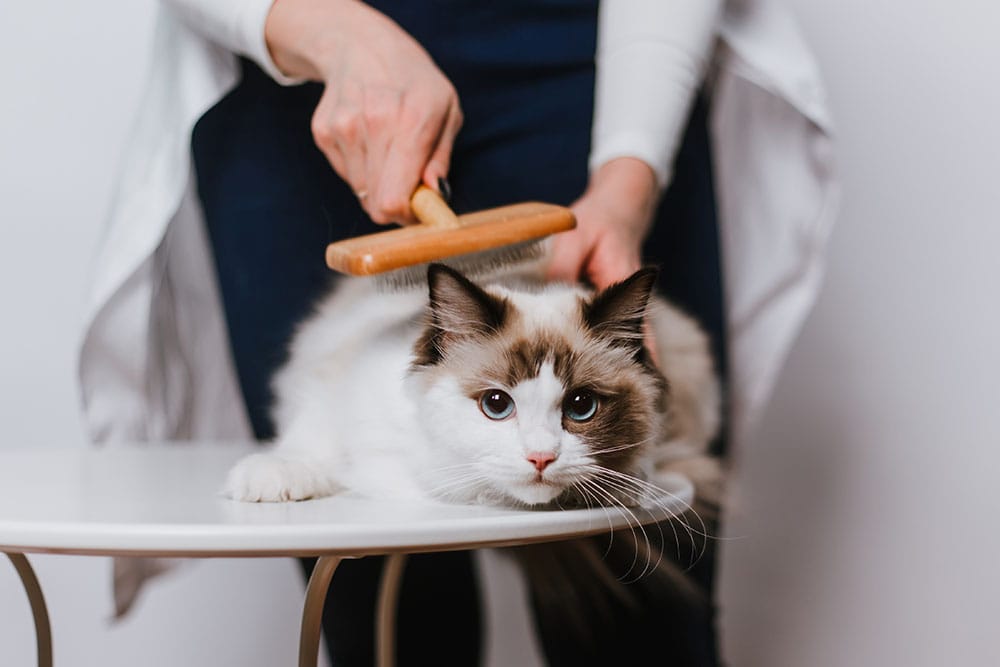
Are you curious about the swimming capabilities of Ragdoll cats? Ragdoll cats are known for their gentle and docile nature, making them a popular breed among cat lovers. But when it comes to swimming, do Ragdolls have what it takes? The answer to this question is not as straightforward as you might think. Let’s discuss.
Can Ragdoll Cats Swim?
Yes, they can (check out this video example), but they’ll need to be supervised and taught. Also, while some Ragdolls may have a natural inclination towards water, others may not be so into it – which isn’t uncommon with cats. It’s important to note that swimming is not an innate skill for cats. Unlike some other animals, cats are not born with the ability to swim. However, certain breeds, like the Ragdoll, may be more inclined to enjoy water-related activities.
Although Ragdolls may exhibit an interest in water, it’s important to remember that their instinctual behavior may still come into play. Like all cats, Ragdolls have an inherent fear of drowning. This fear is deeply rooted in their survival instincts, as cats aren’t naturally equipped for aquatic environments (unlike turtles or otters).
Ragdolls may approach water with caution and may not be comfortable fully submerging themselves. While they may enjoy playing with water, they may not have the same swimming abilities as breeds that are more adapted to aquatic environments, such as the Turkish Van or the Maine Coon.

Why Swimming May Be Good for Your Ragdoll Cat
Swimming offers numerous benefits for cats, including exercise, mental stimulation, and improved muscle tone. It can be especially beneficial for Ragdoll cats that are generally prone to obesity and may benefit from additional physical activity. Swimming provides a low-impact workout that is easy on their joints, making it an ideal form of exercise for cats of all ages and fitness levels. Additionally, swimming can help alleviate stress and anxiety in cats, providing a calming and therapeutic experience.
One of the main advantages of swimming for cats is that it engages their entire body, promoting overall fitness and coordination. It helps strengthen their muscles, particularly the core and hindquarters, leading to improved balance and agility. Swimming also helps with weight management, as it burns lots of calories and helps prevent weight gain. Overall, swimming is a great way to keep your Ragdoll cat active, healthy, and happy.
Tips for Introducing Your Ragdoll Cat to Water
If you’re interested in introducing your Ragdoll cat to water, it’s important to do so gradually and with caution. Here are some tips to help you make the experience as positive as possible:

Progression and Advanced Swimming Techniques
As your Ragdoll cat becomes more proficient in swimming, you can introduce them to advanced techniques and activities to challenge and stimulate them further. These techniques can help enhance your cat’s swimming skills and provide additional mental and physical stimulation.
One advanced technique is teaching your cat to dive underwater. Start by using a toy or treat to entice your cat to reach for it underwater. Gradually increase the depth and duration of the dives, always ensuring your cat is comfortable and not experiencing any distress. This activity can be a fun way to engage your cat’s natural hunting instincts and provide a unique swimming experience.
You can also introduce obstacle courses or agility exercises in the water to challenge your cat’s coordination and agility. Use floating objects or toys to create a course for your cat to navigate through. This not only enhances their swimming abilities but also provides mental stimulation and enrichment.
Safety Precautions While Teaching Your Cat to Swim
While teaching your Ragdoll cat to swim, it’s crucial to prioritize their safety at all times. Here are some important safety precautions to keep in mind.

Other FAQs About Ragdoll Cats
Where did Ragdoll cats come from?
One common question is about the origin of Ragdoll cats. Ragdolls were first developed in the 1960s by a breeder named Ann Baker in California. They’re actually believed to be a crossbreed between a Persian-like cat and a Birman or Burmese cat. The breed got its name from its tendency to go limp like a ragdoll when picked up. Today, Ragdolls are recognized as a breed by various cat registries and have gained popularity worldwide.
What’s the personality of Ragdolls?
Ragdolls are actually known for their gentle and easygoing nature. They’re typically friendly and sociable cats that enjoy the company of their owners and other pets. They’re often described as “puppy-like” due to their tendency to follow their owners around the house and even greet them at the door. Ragdolls are also known to be good with children and can adapt well to a variety of living situations.
Are they hard to groom?
Ragdolls have semi-long hair, which is prone to crazy matting if not properly cared for. Regular daily (or every other day) brushing is recommended to keep their coat clean and free from tangles. However, unlike some other long-haired breeds, Ragdolls don’t have an undercoat, which means they don’t shed as much as you might expect – which is a good thing. This makes them a great choice for people with allergies or those who prefer a cleaner household with less dander on their couches and clothes.

Do Ragdolls eat a lot?
Like any other cat, they require a balanced diet that includes high-quality cat food. So, you’ll need to provide them with the right amount of nutrients to maintain their overall health and well-being. Ragdolls are known for their large size, so it’s important to monitor their weight and avoid overfeeding. Consult with your vet to determine the appropriate feeding schedule and portion sizes for your Ragdoll cat – but know that their diet should include mostly protein from meat like chicken, turkey, beef, and fish.
How long do Ragdolls live?
On average, Ragdolls have a lifespan of 12 to 15 years. However, with proper care and a healthy lifestyle, some Ragdolls have been known to live anywhere from 15 to 20 years. Taking them for annual or semi-annual vet check-ups, offering a healthy balanced diet, and providing them with means for regular exercise (in the form of play around the home) can help ensure that your Ragdoll cat lives a long and happy life.
Do Ragdoll cats get along with dogs?
Ragdoll cats are known for their gentle and laid-back nature, which often makes them a great choice for families with other pets, including dogs. While every cat is unique and has its own personality, Ragdolls generally have a friendly and sociable temperament that allows them to get along well with dogs – this granted the dogs are friendly as well.
One of the reasons why Ragdoll cats tend to get along with dogs is their calm and easygoing nature. They are not easily startled or aggressive, which helps them to adjust to the presence of a dog in the household. Additionally, Ragdolls are known to be very tolerant, making them more likely to tolerate the presence and behavior of a dog without getting easily stressed or agitated.
That being stated though, introducing a Ragdoll cat to a dog should be done gradually and with caution, as with any introduction between two pets.
Wrapping Things Up
So, while Ragdoll cats may not be natural-born swimmers, many of them do actually have a natural curiosity and fascination with water. Some Ragdolls may enjoy playing with water toys or watching drops fall from a faucet, while others may even dip their paws in water bowls. However, it’s important to remember that each Ragdoll has its own unique preferences and comfort levels when it comes to water-related activities. Whether your Ragdoll is a water enthusiast or prefers to stay dry, always prioritize their safety and well-being.
Featured Image Credit: whitejellybeans, Shutterstock








